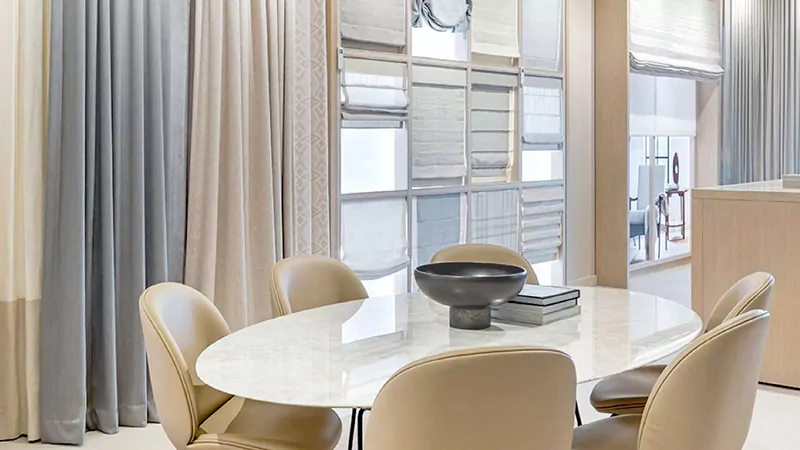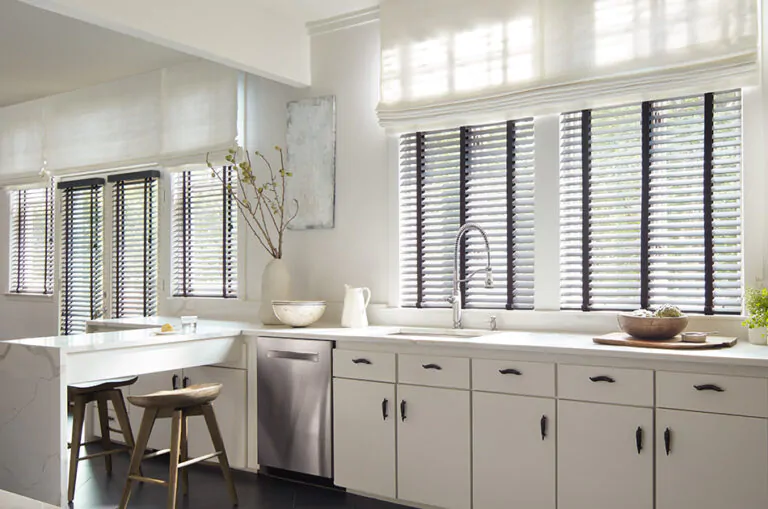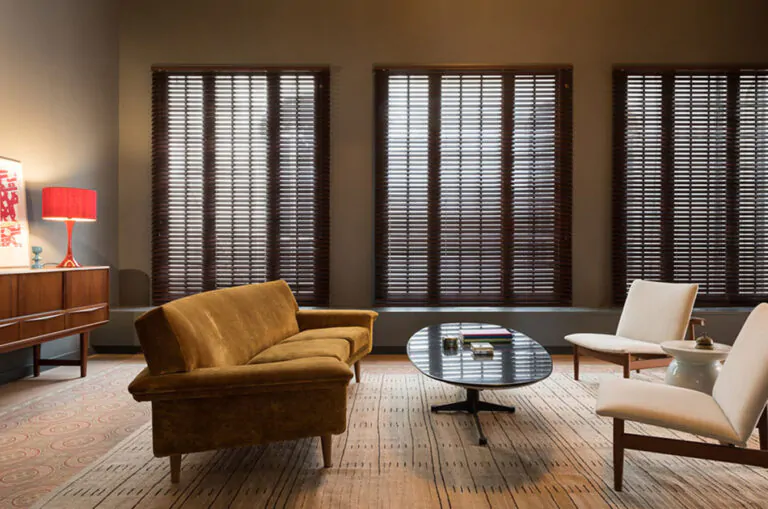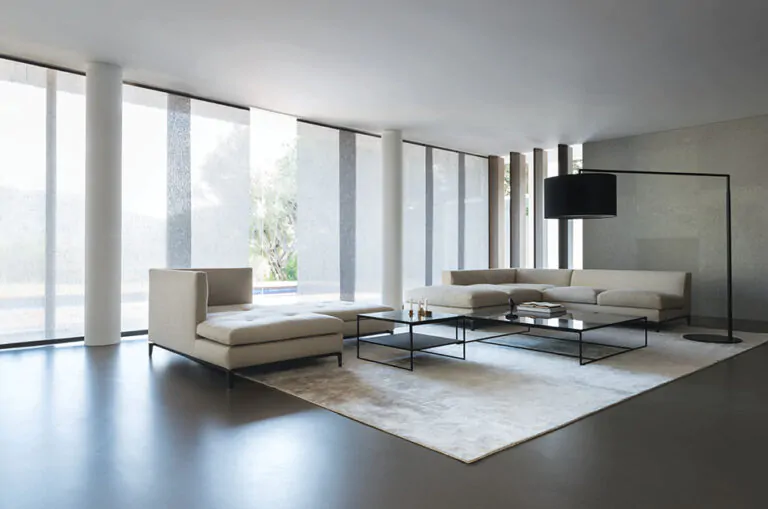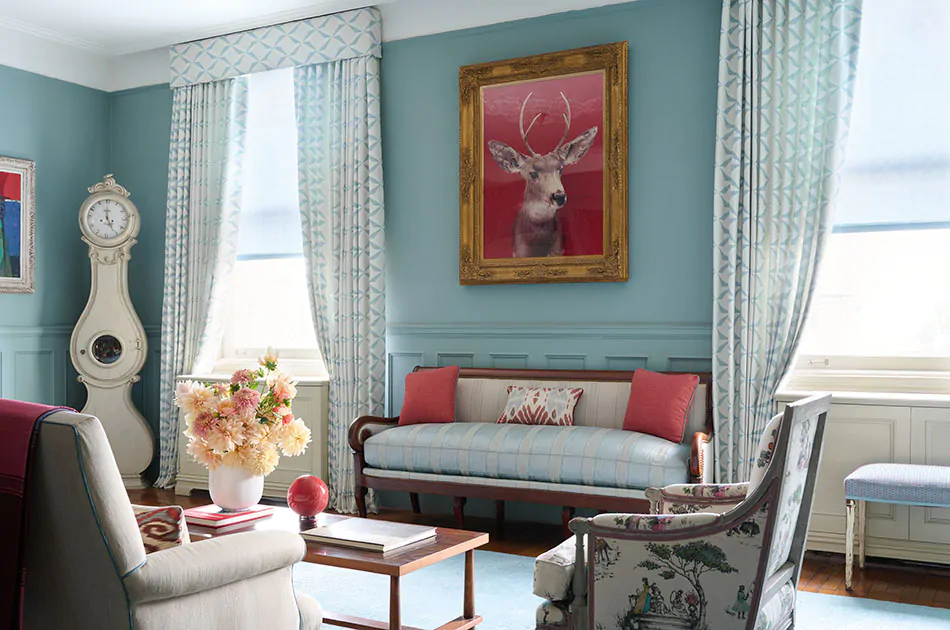
Blinds vs Curtains: How to Choose
Blinds vs curtains: Which is best? Both window treatment options offer effective light and privacy control and come in a variety of styles to suit your tastes. Choosing the best one between the two comes down to your specific needs and preferences.
To help you decide between curtains vs blinds, first learn what exactly each type of window treatment is and how it functions.
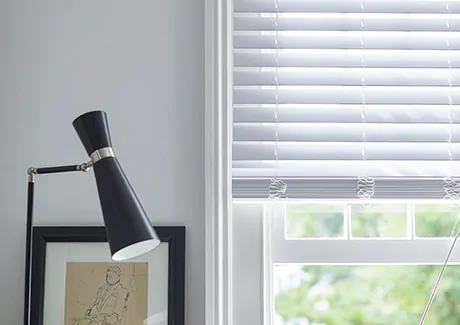
Blinds
The term “blinds” refers primarily to window treatments made of slats running horizontally across the window and held together by braided ladders of strings running in between the slats. To control your blinds, you can either tilt the slats up and down or lift and lower them.
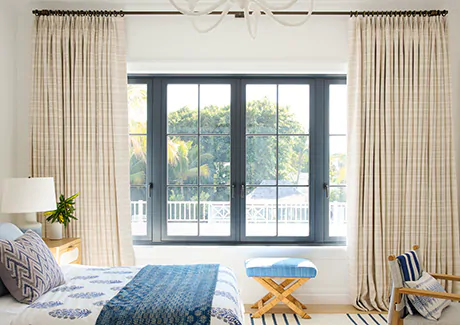
Curtains
Curtains, also called “drapery,” are panels of fabric hung on a rod or a track system above your window. They are typically sold in pairs but can sometimes be sold as a single panel. To control your drapery, you simply pull the curtain panels back and forth across your rod or track system to open and close your window.
“Blinds” can also refer to vertical blinds, which are tall panels running from the top of your window to the floor. The panels typically run on a track system for easy movement back and forth.
In this comparison, we’ll primarily be comparing traditional horizontal blinds with curtains.
Considering Other Window Treatments?
Learn the differences between all the main types of window coverings including Drapery, Shades and Blinds in our comprehensive guide. READ THE GUIDE
Now that you’re clear on what curtains and blinds are, you’re ready to take a deep divine into comparing blinds vs curtains across several different topics.
Blinds vs Curtains: Comparison
When it comes to deciding between blinds vs curtains, you need to understand the two across several topics to get a full picture of the pros and cons of each.
Compare curtains vs blinds through the lens of the following topics to better understand which is best for your home:
In this article
Aesthetics & Design Versatility
When it comes to looks, comparing blinds vs curtains creates stark contrasts because they offer such different aesthetics. Blinds are made from hard material such as wood, metal or sometimes plastics, while curtains are made from soft, flowing fabric.
Compare curtains vs blinds in terms of aesthetics and design versatility to see which one suits your style best.
Blinds Aesthetics
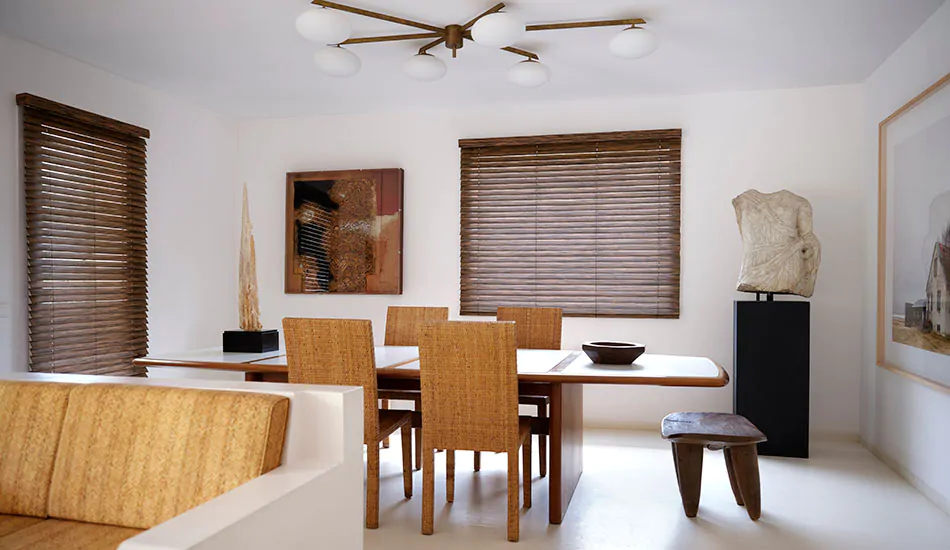
When comparing blinds vs curtains, blinds tend to be a more utilitarian window treatment option than drapery, often featuring a greater focus on function rather than form. Their slatted design delivers excellent light and privacy control by allowing you to tilt the slats as well as lift and lower the blinds with cordless control. Yet, their high functionality does not mean they are devoid of style. Those same slats deliver a defined linear look that can suit many different aesthetic styles, from traditional to modern. However, in terms of overall visual impact, blinds are more subtle than drapery, making them a great option when you don’t want your window treatments to distract from the rest of your space.
Still, you do have plenty of choice when it comes to style for your blinds.
Wood Blinds come in many wood grains and finishes, from exotic wood aesthetics with lots of color and grain variation to more chic painted wood looks with a more minimalist look. The real wood look of these blinds can suit a range of styles but are typically best geared toward mid-century modern and Scandinavian-inspired spaces that champion natural materials and minimalism.
Metal Blinds also range in colors from metallic silver and gold to more muted white and black. They’re available with 2-inch slats as well as slimmer 1-inch slats. The metallic nature of Metal Blinds means they look right at home in modern and industrial spaces.
Drapery Aesthetics
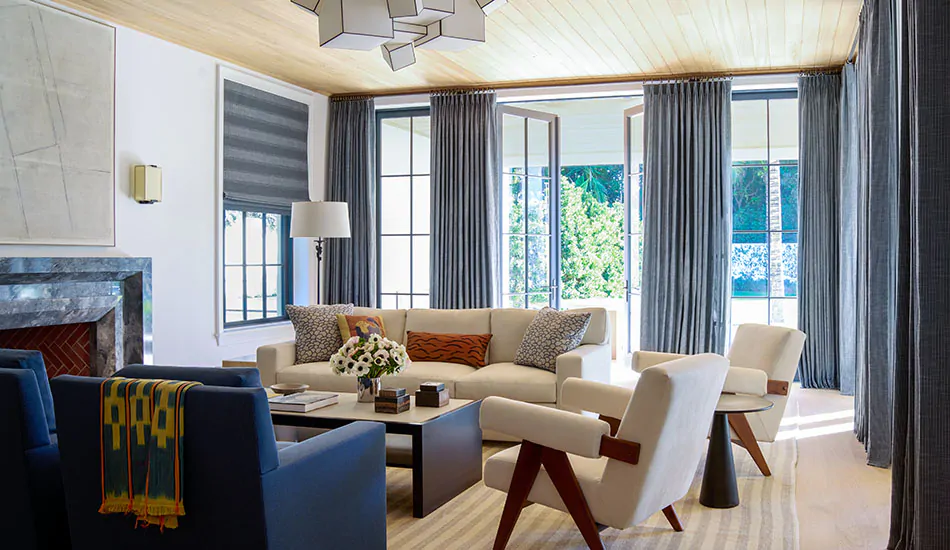
When comparing curtains vs blinds, it’s clear that curtains give you a lot more design versatility. With numerous fabric options from sheer to blackout materials, different pleating styles, as well as a wide range of colors and patterns, you can find the right drapery for every room in your home. Whether you’re going for an elegant, traditional aesthetic, or a sleek contemporary design, there’s a drapery style to suit your preferences.
The Shade Store Recommendation
When it comes to blinds vs curtains in terms of aesthetics, it comes down to personal preference and the effect you want to have in a room. Are you looking for easy functionality and a natural warm wood tone or an industrial-chic metallic sheen? Go for Blinds. Or are you looking to make a visual impact and add luxurious elegance to a more formal room like the dining room or living room? Then Drapery is your best bet.
Ease of Use
Between blinds vs curtains, ease of use will depend not just on which one you choose, but which kind of control type you have for your window treatment.
Blinds Ease of Use
Blinds are available with cordless control as well as motorized control. Both cordless and motorized blinds offer easy functionality and a clean look without any dangling cords.
Cordless blinds can be lifted and lowered and the slats can be tilted. To adjust the height of your cordless blinds, simply grab the bottom bar of your blinds and pull down or lift up. For slat control, twist the wand to adjust the slats. Cordless control is available for 2-inch Wood Blinds and 2-inch Metal Blinds. 1-inch Metal Blinds are only available with tilt control, no lift.
Motorized blinds use a motor to control the tilt of the slats. Motorization does not control the lifting or lowering of your blinds, just the tilt. To tilt the slats of your blinds with motorization, you can use a remote, an app on your smartphone or even the sound of your voice when you pair the motor with a smart home device.
Drapery Ease of Use
When it comes to curtains vs blinds, curtains range significantly in their ease of use — and it depends on a few different factors, such as:
- How you mount your drapery (rod and rings or a track system) – A track system is by far an easier way to open and close your curtains. In a track system, your drapery panels are attached to hooks within a track that allows the panel to glide seamlessly back and forth. Rod and rings can be a bit more difficult to use, since the rings can sometimes catch on the rod and they will be stopped completely by any brackets in their way.
- Which drapery pleat style you choose – Some pleat styles are made for decorative use, while others are meant to be functional. For instance, Ripple Fold Drapery is designed specifically for a track system, so functionality is a breeze. Meanwhile, Grommet Drapery features large rings embedded into the fabric and can only be used on a traditional rod, making them a bit more difficult to use.
- The control type you choose – Different control types are only available for drapery on a track system. For rod and rings systems, you pull the drapery back and forth with your hand on the fabric which can be difficult, especially if your drapery is mounted high. For track systems, your options include a baton draw, a cord draw, and motorization. Ease of use is relatively equal across all track system control types, with motorization being the easiest of all, as it only requires the press of a button on a remote, an app, or using the sound of your voice when paired with a smart home automation system.
The Shade Store Recommendation
For ease of use, between blinds vs curtains, blinds are likely the better bet for any standard or small-sized window. When windows start getting wider than about 72”, Blinds can be difficult to lift with cordless control, so it’s often better to go with Drapery on a track system; and add motorization for effortless ease.
Light & Privacy Control
Light and privacy control refers to how well your window treatments block light and prevent passers-by from seeing into your home. Between blinds vs curtains, both offer options for different levels of privacy and light control, but in very different functionalities.
Blinds Light & Privacy Control
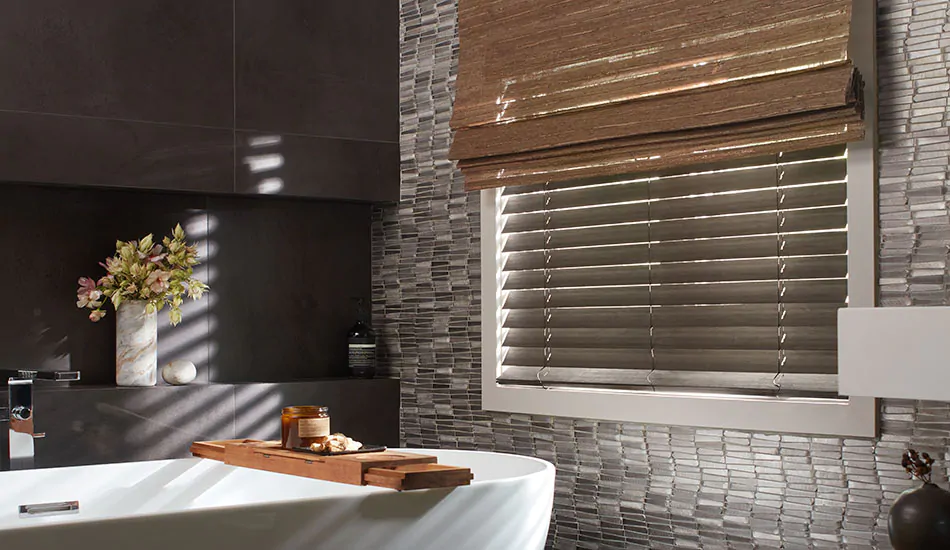
Blinds offer great functionality when it comes to light and privacy control whether you tilt the slats or lift and lower the blinds. Since most traditional horizontal blinds are made from a hard, opaque material, you can block most light coming through the window and block your view simply by lowering your blinds and tilting the slats up or down. For gentle light filtration, just tilt the blinds until the desired amount of light is filtering through. Keep in mind though, the more you tilt the slats open, the less privacy you have. Additionally, due to the braided ladder cords in between the slats, some light may still be able to seep through, even when the slats are tilted closed. For the best room darkening effect, add decorative tape to your blinds, which covers the cords and provides a bit more coverage. However, decorative tape is only available for Wood Blinds with no lift functionality–you’ll only be able to tilt the slats.
Drapery Light & Privacy Control
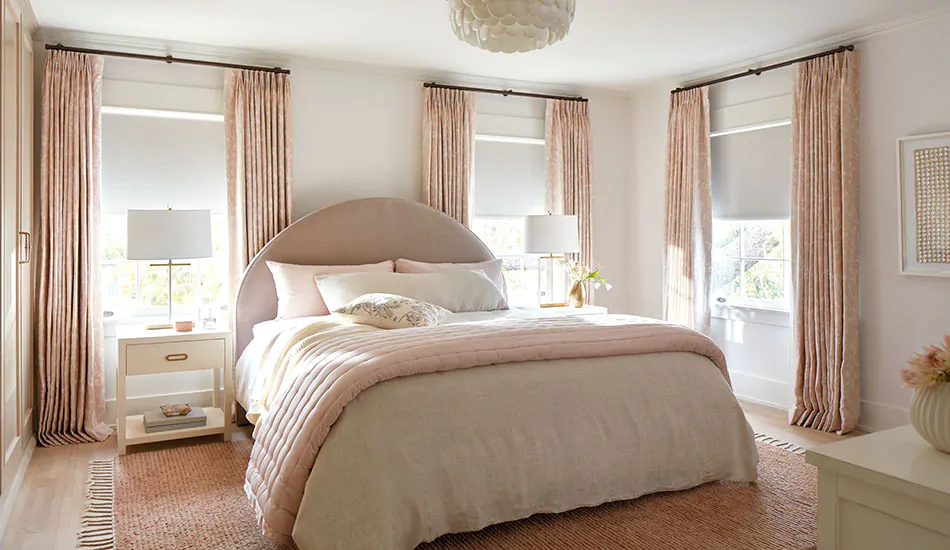
Between blinds vs curtains, drapery only has one mode of controlling light and privacy vs two modes for blinds: drawing the curtains open or closed. However, curtains are available in many materials with different weights and light filtration levels, and you can also add privacy and blackout linings. All these options give you greater control of your light and privacy when you layer drapery of different materials on a double rod or track system.
For example, layering sheer curtains on the inner track or rod under curtains with blackout lining on the outer track or rod gives you three levels of light and privacy:
- Open when both layers of curtains are drawn open.
- Semi-private with a soft glow of natural light with the sheers drawn closed.
- Total privacy and a room darkening effect with both the sheers and blackout-lined drapes closed.
the shade store recommendation
If you need the best blackout light control and privacy, such as in a bedroom, go for blackout Drapery. However, if easy control of your light and privacy is preferred, and you don’t require the best room darkening effect, Blinds can be a good choice as their tiltable slats make control a breeze.
Insulation
Insulation refers to the window treatment’s ability to help regulate your interior temperatures by preventing heat buildup, blocking cold air, or both. In comparing blinds vs curtains, curtains are often better suited to insulation, especially those made from heavier fabrics.
Blinds Insulation
Blinds alone do not provide effective insulation. While blinds can block most of the light coming through your window, which helps reduce heat buildup in the room, they do not provide much defense against a drafty window. Their hard slats don’t do much to block a draft or absorb moisture, both of which contribute to creating a chill in the room, so a room with blinds may still feel cold during the colder months.
Drapery Insulation
Between blinds vs curtains, drapery is a better choice for regulating interior temperatures as it blocks out the sun to keep rooms cooler and helps insulate any drafty windows with its long fabric to keep your rooms warmer. Heat buildup can be mitigated significantly with a sheer or light filtering fabric but is best abated with thicker material like velvet and privacy or blackout lining. When it comes to blocking a drafty window, go with a heavier fabric like wool, which is great at absorbing moisture and blocking a draft with its thick material.
the shade store recommendation
Between curtains vs blinds, for the best insulation, choose thick Drapery like velvet or wool. Add a privacy or blackout lining for even more weight to block the cold and heat alike.
Durability
Durability is all about the strength and longevity of the material your window treatments are made of. When comparing blinds vs curtains, there are variations for durability based on the exact material the blinds or drapes are made from.
Blinds Durability
The durability of blinds will vary based on what material they’re made from. Wood, Metal and Faux Wood Blinds are extremely durable, with faux wood and metal also being resistant to moisture and humidity.
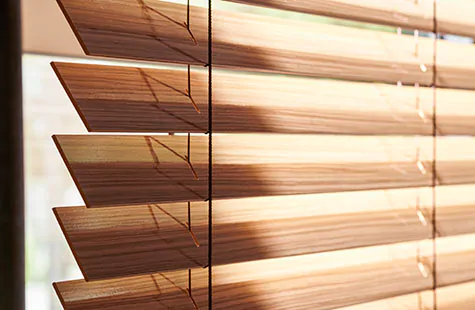
wood blinds
Wood Blinds are typically made from American Basswood, a hardwood that’s ideal for blinds thanks to its light weight and fine, uniform texture.
However, wood is vulnerable to moisture and humidity, which can cause the wood to warp, so wood blinds are not an ideal choice for bathrooms or basements.
Metal & Faux Wood Blinds
Metal Blinds (pictured) are made from lightweight aluminum, while Faux Wood Blinds are made of foamwood. Both are very durable and long-lasting, and are also resistant to moisture, making them better suited to rooms with moisture and humidity like bathrooms.
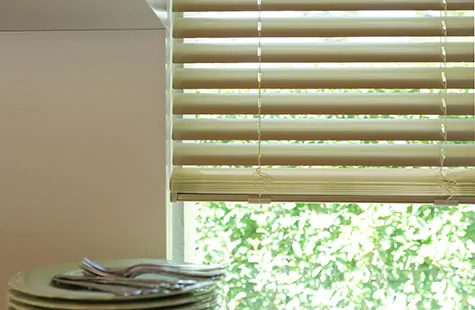
Drapery Durability
The durability of your drapery will depend on the material chosen, but generally as a soft fabric, drapery is a little more vulnerable to wear and tear than blinds.
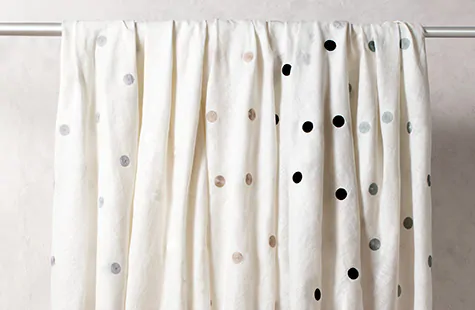
natural materials
Some natural materials, like silk are delicate in nature and require gentle use and care. Delicate natural fibers will also benefit from protective lining to keep UV rays from damaging the fibers. Other natural materials like linens and wools are hardy fabrics, but will show wrinkles and stretching from moisture and gravity more readily. However, these are expected and even desirable for these fabrics as they are considered charming characteristics that showcase the high-quality, natural material.
synthetic materials
Synthetic options like Sunbrella’s mix of acrylic and polyester fibers, are the hardiest materials and will look pristine for the long haul. Plus, they don’t need protective lining, as their synthetic fibers are not as vulnerable to UV rays.
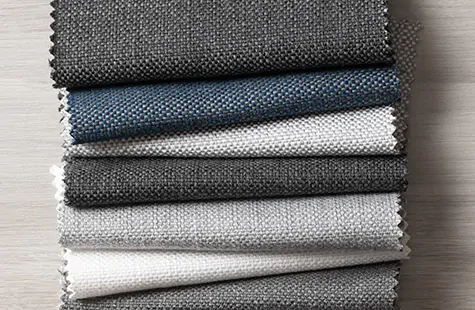
the shade store recommendation
For window treatments that will easily stand up to normal wear and tear, humidity and the occasional spill or ding, go for Metal or Faux Wood Blinds. Rooms like the bathroom, basement or kitchen where moisture and activity levels are their highest are best suited for blinds.
If you’re decided on Drapery, but still need good performance, opt for a synthetic fabric like Sunbrella which resists dirt and mildew and is easy to clean.
Upfront Costs
The upfront costs of your window treatment project include only the materials you’ll need. Total project costs will depend on more factors such as if you’ll hire professionals for installation or DIY the job yourself.
For comparison between curtains vs blinds here, we’ll only compare based on upfront material costs.
Blinds Cost
To cover the exact same area, blinds are typically more affordable than drapery since they use less material overall. Additionally, in some cases, as in aluminum blinds, the material itself can be less expensive as well.
Drapery Cost
Drapery will typically cost more than blinds to cover the exact same area, due to the sheer amount of material they often require. Plus, drapery also requires more components for installation, including not only the curtain panels, but also the hardware such as rod and rings or track system, brackets, etc.
the shade store recommendation
Between curtains vs blinds, the more affordable upgrade for standard-sized windows will be Metal or Faux Wood Blinds.
Installation
Comparing installation between blinds vs curtains is simply a matter of comparing the amount of time and effort it takes to mount them and get them functional.
Blinds Installation
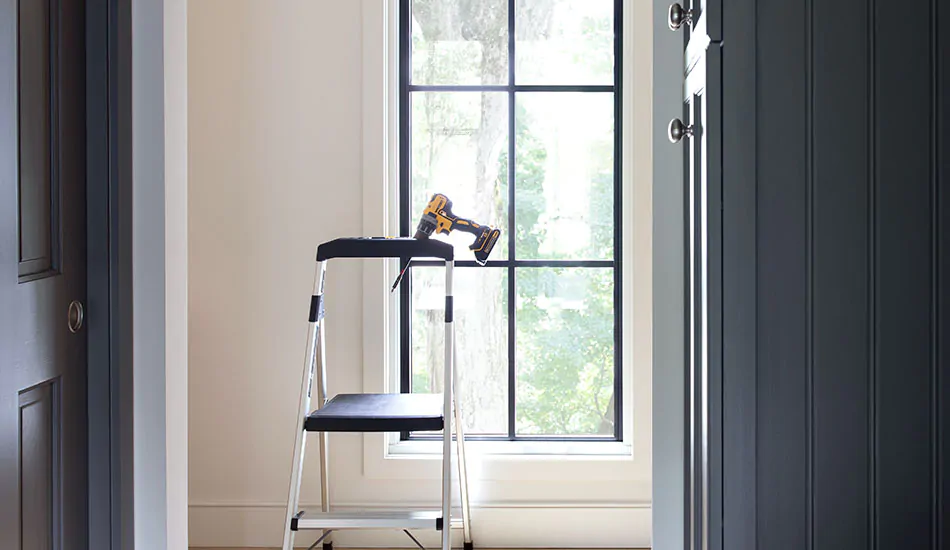
Between blinds vs curtains, blinds benefit from a more straightforward installation process. Review these simplified steps to get a sense of the process.
- Step 1: Gather tools. You’ll typically need a stepladder, pencil, tape measure, level, drill and screwdriver, but check your blinds’ specific install instructions for an exact list.
- Step 2: Decide whether you’ll inside or outside mount your blinds, which means deciding whether to place them inside the window frame (inside-mount) or outside the window frame on the wall (outside-mount).
- Step 3: Measure appropriately based on your mount choice and mark where the mounting brackets and headboard will go.
- Step 4: Install the brackets in the right place with the appropriate tools and indicated in the installation guide for your chosen blinds and then attach the headrail.
Drapery Installation
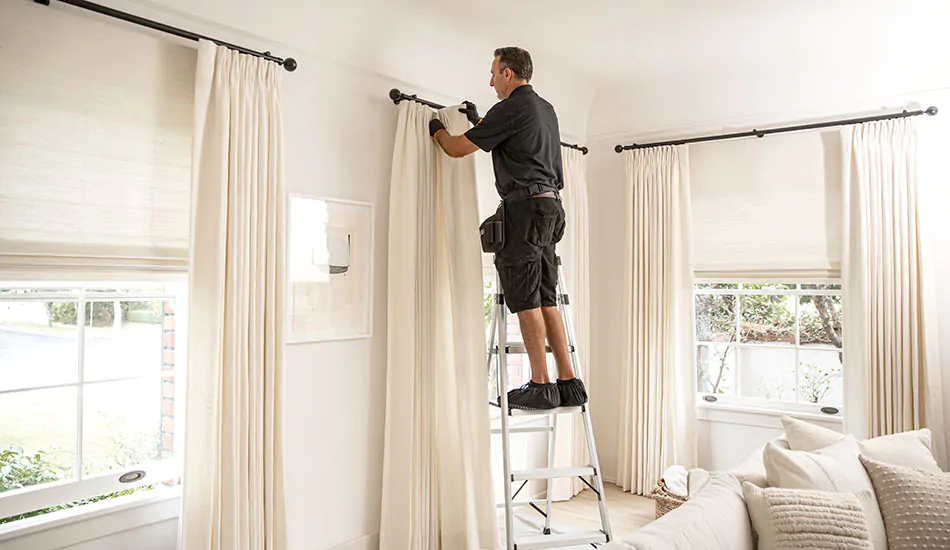
When comparing blinds vs curtains, drapery requires a couple more steps than blinds, but it is still relatively straightforward. Review these simplified steps to get a sense of the process:
- Step 1: Gather tools. You’ll likely need a stepladder, pencil, tape measure, level, drill and screwdriver, but check your drapery’s specific install instructions for an exact list.
- Step 2: Measure how wide your curtain rod or track system will be. For best practices, go beyond the window about 6 to 12 inches to ensure enough space for your curtains to be drawn completely off the window.
- Step 3: Decide on curtain length and how high above your window the rod will go (a little more than halfway between the top of your window frame and ceiling is usually a good height).
- Step 4: Measure for bracket placement. Be sure to check your drapery hardware install guide to ensure proper spacing of brackets.
- Step 5: Install the brackets with the correct tools as indicated in the installation guide for your drapery hardware.
- Step 6: Mount the rod and hang your drapery.
the shade store recommendation
Between blinds vs curtains, both have straightforward installations, but Blinds will inevitably take less time thanks to fewer steps. However, installation ease or difficulty will ultimately boil down to your skillset and comfort level. To avoid the hassle yourself, you can take advantage of The Shade Store installation services.
Maintenance
Some level of maintenance is essential for any window treatment to keep them looking their best and functioning optimally. Between blinds vs curtains, maintenance needs vary considerably.
Blinds Maintenance
Maintenance for blinds is relatively easy. To keep your blinds clean, simply wipe the slats with a damp cloth. This can be done to blinds of any material, from real wood to faux wood to aluminum. Just make sure to not leave any moisture lingering on your blinds. Wipe your blinds again with a dry cloth as needed to remove any excess moisture.
Drapery Maintenance
Between blinds vs curtains, maintenance for your drapery can be more intensive, but its exact needs will depend on material. While all materials benefit from vacuuming now and then with a low-suction, handheld vacuum to remove dust and dirt, if dirt gets embedded, or there’s a stain, more drastic measures will need to be taken.
Cleaning Stains in Drapery
For most drapery materials, it’s best to rely on a professional window treatment cleaning specialist who can treat your drapery onsite — often without even taking it down. You can also sometimes bring your drapery into your local dry cleaner.
If you have Sunbrella drapery material, you can likely clean stains at home. For most liquid spills get as much of the liquid out as you can by blotting with a clean, dry cloth. For oil-based stains, first apply an absorbent like cornstarch, then remove it with a straight edge. Next, spray on a mild cleaning solution of dish soap (like Dawn) and water. Then rinse the fabric thoroughly to remove all soap residue and let it air dry.
Additional Maintenance for Natural Materials
For some natural materials like silk, linen and wool, some additional maintenance beyond cleaning may be required. As these materials hang, over time gravity will gently stretch the fabric, causing it to puddle more and more on your floor. If you open and close your curtains every day, you’ll likely need to hem the bottom occasionally to ensure the drapery stays at a good floating length above the floor for easy use.
the shade store recommendation
For the easiest maintenance, between blinds vs curtains, Blinds are best, because you will likely only ever need to wipe them with a damp cloth. If you’re decided on Drapery, choose a high-performance fabric like Sunbrella, which is easier to clean than naturals like silk or linen.
After a thorough comparison of curtains vs blinds, you have a lot of insight to help you decide which is the right one for your space.
Finalize Your Choice: Blinds or Curtains?
With an in-depth comparative analysis of blinds vs curtains, you’re ready to finalize your decision. Visit your local showroom to further compare curtains vs blinds, and all your options for each, up close. Play with different control types like cordless blinds, track system drapery and motorization, and explore your material choices for both. Plus, you’ll find friendly Design Consultants ready to answer your questions and help you choose the perfect option (or combination) for your home.
